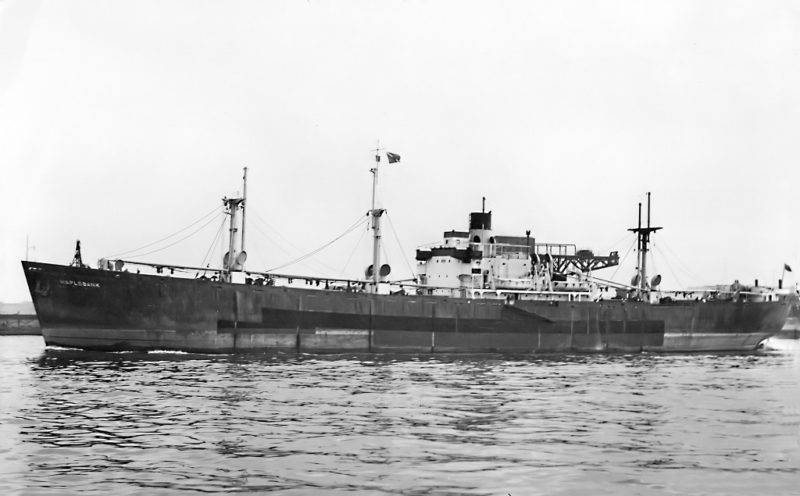
They were like nothing else, with their own very distinctive character and appearance. The Liberty ships, while they were with us they more than earned a permanent place in maritime history. Strangely, they went from being called, “Ugly Ducklings” at the outset, a name which stuck, to enjoying a considerable fan base as the numbers shrank after the war. The maritime community at large now has some affection for the ships, based both on personal experiences and their wartime service, and today the profile is much loved by many. Now they are gone, apart from preservation examples, and the people that were privileged to sail on them will also soon be gone….
A remarkable 2,710 Liberty ships were built, some in very short time, and the deeds of some have remained permanently in maritime history. It was a herculean effort by the USA workers. Probably the most well known vessel in public circles is the S.S. Richard Montgomery, sunk in WW2 near Sheerness with explosives onboard and still a danger to the neighbourhood to this very day. The masts remain above water for all to see, but she is too delicate to move.
Another spectacularly went into the history books as the only merchant ship to sink a German raider in WW2, the German armed raider Stier sunk by a Liberty vessel called Stephen Hopkins. On 27th September 1942 they met at short range in foggy conditions when on passage from Cape Town to Paramaribo. The action was totally uneven as the Liberty ship had minimal armaments consisting of 1 x 4 inch gun, 2 of 37mm, and some machine guns, but by giving up a spirited defence however, the crew and gunners of Stephen Hopkins managed to fatally cripple the raider. It took some good shooting and the Stier was scuttled two hours after their own ship was sunk. Posthumous awards were made to the master and the crew of the Liberty, most of whom were lost in the action. The 15 survivors spent 31 days in an open boat commanded by the second engineer, and which eventually reached the Brazilian shore safely.
The catalogue of war time exploits and numerous sinkings of the Liberty ship fleet is vast given the numbers involved, and many seamen were lost or suffered dire conditions in the conflict. Those destroyed when carrying ammunition cargoes come to mind. When peace finally came, the large number of surplus vessels exceeded demand. Many went into mothball and were stacked bow to stern like sardines in creeks and bayous in the USA. Hundreds of others found a new life with commercial shipping lines, and many owners chose to alter the appearance to suit their particular aims. A few were lengthened, but most were content to tidy up the appearance. Interestingly, just like motor cars, there was definitely an image issue, and some owners proud of their fleet appearance strove to make their particular Liberty ships different, altering the accommodation and adding touches to make them stand out. After some years service, often while owners were awaiting new built tonnage, many of them found their way into Chinese ownership giving further service way beyond their intended use in WW2.
One of the purchased Liberty ships was renamed the Maplebank and was in the Bank Line fleet for 10 years, circling the globe. I was fortunate enough to experience a long and event filled voyage around the world on her with a crew mainly from Liverpool. She was one of a dozen that Bank Line owned, the largest number in the British merchant navy for one owner. When sold on in 1957, she became the Liberian flagged African Lord, and after nearly 20 years afloat she had the misfortune to sustain severe damage in a collision in the New Waterway, which resulted in her being sent off for scrap. The Kelvinbank grounded on Ocean Island in mid-Pacific where she remains.
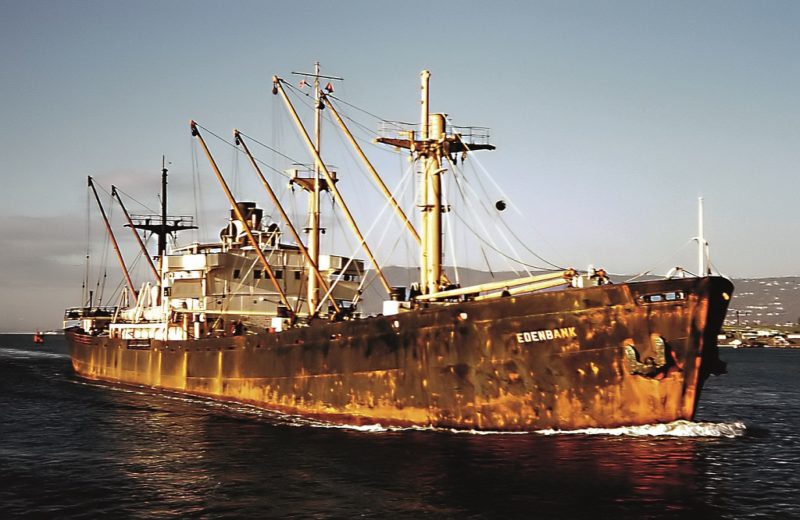
The Edenbank deteriorated into an example of the proverbial ‘rust bucket’, but went to Chinese owners who named her ‘Hoping 43’ when bought from the Bank Line in 1960. She had spent over 30 years afloat before going to scrap.
My particular ‘Liberty’ was launched as the Harmon Judson, named after a prominent American politician born a hundred years earlier. On transfer to the UK under the Lend Lease arrangements along with dozens of others she took on the distinctive “Sam” prefix as the Samwash. The records show her wartime movements which include 9 short round trips from Southend to Antwerp, presumably supporting the Allied armies in the newly recaptured port and in the hinterland prior to the end of the war.
Some Liberty ships fresh from the yard were lost at sea prior to any action, and many were damaged by sudden worrying and unexplained fractures. Later, careful analysis showed that the problem was ductile fracture, caused by low temperatures making the steel change characteristics, and become brittle. In some of the vessels Bank Line bought, incidents occurred where alarming cracks appeared across the deck. These were repaired satisfactorily under survey using thick steel straps.
Joining the Maplebank in mid-winter in Bromborough dock on the Mersey there was snow and ice on the quay. She was discharging Copra and coconut oil from the deeptanks, and the warm distinctive, rather cloying smell permeated everywhere. It was not unpleasant, and it immediately conjured up visions of the Pacific islands, where she had recently been.
Once onboard, it was immediately clear that the standards of a Liberty ship was unlike the other Bank Line ships, and the most obvious difference was the ‘chunkiness’. Fittings and furnishings, including the cabins and the equipment on the bridge all had a more robust feel. Bunks were noticeably wider, and they were finished with more and better quality wood than usual. Radiators in all the rooms belted out heat more than sufficient for cold winter days. There was a general feeling of ‘no nonsense’ equipment as standard. Running water in the cabins was a novelty in the Bank Line in the 1950s! Steam winches on deck however gave a comforting feeling of familiarity.
The profile and appearance of the ‘Libertys’ was quite distinctive. Gun bays remained on many of them, whilst some owners opted for their expensive and cosmetic removal. From a distance the original masts (kept by most owners) sported a top gallant mast on the main, a most unusual arrangement in post-war building. So, looking from afar, the towering thin t’gallant immediately shouted “Liberty Ship”. On the Maplebank, use was made of this very high mast, mostly used for signal flags, to carry an aerial at sea, one which also served the apprentices shortwave radio brilliantly. The ships had a rather big bluff bow. All of the accommodation was in one central block, and at the heart of it was the galley, sandwiched between the two alleyways. Derricks at the hatches were topped in the usual way and secured with chains and a shackle to a deck plate with the exception of number 3 hatch where the topping wires were cleated onto the mast house. This system gave rise to fun moments when the apprentices were told to lower those derricks, and it was done by loosening the strands on the cleat and allowing the derrick to snatch up the slack that was created, usually in a nice shower of rust and sparks. We had to get our fun somewhere, and ‘health and safety’ regulations were absent big time!
Down below, the engines and the layout were simple even by the standards of the day. A big chunky looking triple steam expansion engine was the heart of the ship. It produced 2,500 HP with 3 cylinders and ran at 60 to 62 rpm. This produced a bog standard speed of around 10 knots, but 12 knots could also be achieved if desired. Consumption of fuel at 60rpm was a lowly 10 tons per day.

One interesting job each watch below was to test the bottom end main bearings for over heating. A careful manual check on the running engine involved inserting an arm and fingers between the crank and the bearing where a 3 inch gap existed. This had to be done of course while the huge crank was flying round, so best done stone cold sober. The whole open display of thrashing pistons and associated cranks was a truly impressive sight on the Liberty ships, and not easily forgotten.
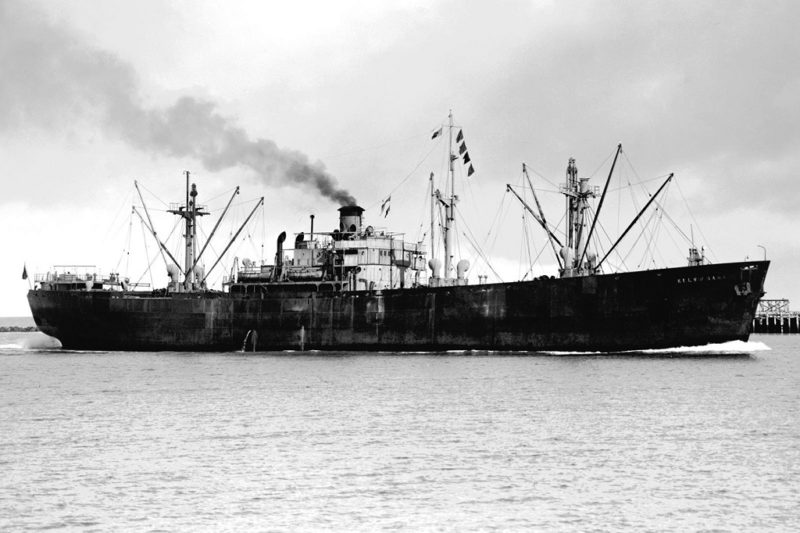
The Maplebank loaded around the Gulf States for New Zealand, and this followed a light ship passage across the Atlantic. During this time the apprentices and the Liverpool seamen largely worked together on the maintenance chores of painting, scraping, and oiling wires etc. It quickly became apparent that the seamen that were signed on at departure were not only excellent seamen, but that they had a penchant for trouble, coupled to a fine sense of humour. A necessary but strange job given to the apprentices by the mate, keen on maintenance, was the cosmetic improvement given to bulwark plates that had rusted right through leaving jagged holes. We applied old chart paper, which we stuck on, and then the whole was painted over beautifully, giving an appearance close to new!
Arriving at Cristobal for the Panama Canal transit, most of the crew went ashore, made merry, and refused to come back. Hasty consultations between the ship, the pilot, the Agent, and the police ended with us proceeding through, apprentices and mates manning the stations fore and aft, and steering. Many Liberty ships were steered and conned from the upper bridge. Here, above the main bridge, it was quite common for the owners to have built a small wheelhouse, some better than others. Ours was adequate but small and this enabled the helmsman, if required, to not only steer but blow the whistle or even ring the telegraph, and this was both an experience and great fun to the apprentices. The urgent crackle barked out messages on the pilot’s walkie talkie radio kept the Captain, and the rest of us abreast of the hunt for his crew. Arriving in Balboa Bay we then went to anchor, and the police launch brought our crew back, still in a rebellious and aggressive mood. The long Pacific crossing allowed ample time to sober up, but it was only the calm before the storm. Once on the New Zealand coast, the fun and games started, fuelled by constant drinking. Later in the voyage, when things became dire, before they all departed ashore permanently, it was the wit and irreverence that we enjoyed on awkward days. Often, no-one was sober enough to do the essential work on deck before departure, so it was left to the 4 apprentices, sometimes aided by the mates.
Covering hatches, the old hatchboard/ tarpaulin/wedges routine, lowering the derricks and then steering for long spells on departure became a regular procedure. It was great that we were young because the hard work and long hours in some ways was compensated by the events that were witnessed by us with some awe. Daily fines accompanied by an entry in the log book were many and frequent, but nothing seemed to change. Eventually, the Bos’n and his team all found jobs ashore, driving taxis or better still, serving in a dockside bar. They left everything behind, forfeiting their wages, and started life anew. Attempts to round them up fell to the apprentices who were met with some choice language. We were then furnished with seamen that had been apprehended from previous desertions and who were in police custody. The idea of leaving the ship must have been catching because, surprisingly, one of the apprentices also chose to ‘jump ship’ leaving the three of us to carry on.
The Liberty ship design amply suited the carriage of bulk cargoes and so after discharge we were nominated to spend time running phosphate rock, needed for the Australian and New Zealand farmers, from Nauru and Ocean Island up near the equator. Several trips were made. The route included passages via the Tasman sea which was often extremely rough. When fully loaded down to our marks and southbound, it wasn’t unusual for green seas to be shipped over the bow.
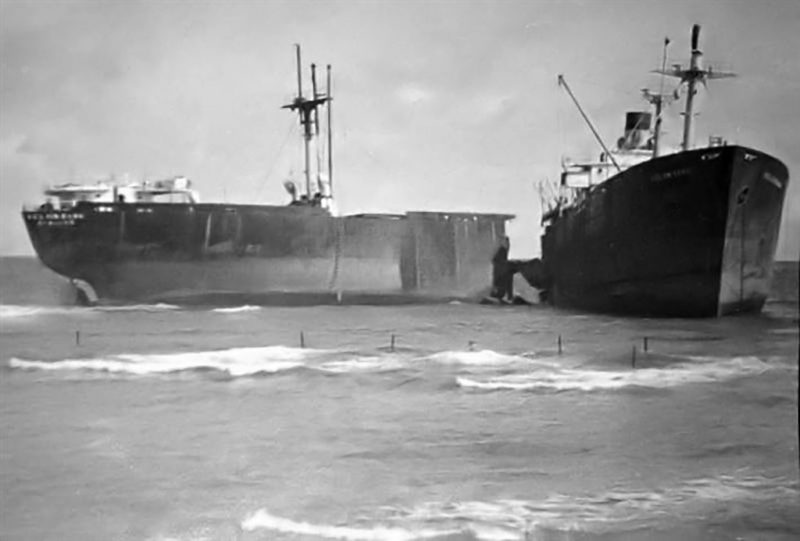
Before they left, and on this so-called phosphate run, our wayward crew had taken to stowing girlfriends away in the accommodation for these 10 day passages. This went on for a couple of round trips without much comment, and then disaster suddenly struck when we were diverted to New Zealand to discharge our cargo there instead of Australia. On came the customs rummagers who quickly found some unusual live contraband! More fines ensued.
There were happier times too, such as when we played cricket or football ashore against local teams, and there was a memorable game of cricket at Ocean Island when the ball often disappeared down the deep cast-out workings of the phosphate mine that surrounded the field. The crew we had also excelled themselves at the ‘crossing the line’ ceremony when King Neptune visited during the Pacific passage.
As the voyage progressed, we signed on new crew members but the drinking and general mayhem continued when drink was freely available ashore. We proceeded with grain to India, and then a full load of mainly gunny bales for Uruguay and Argentina, where we docked first in Montevideo, and then in Buenos Aires for a lengthy stay.
A wild time was had by all here. It was near the end of President Juan Peron’s time, and discipline ashore was strict. However, in the docks there were notorious areas like ‘The Arches’ where anything went, and a good time could be had by all. Piano bars, tango saloons, eateries, serving big steaks with the famous ‘Befe de Lomo’ being top of the list. It was a sort of seaman’s paradise, and our visit culminated with the local shore police firing at our deck crew returning in a drunken state in the early hours one morning, and generally causing a disturbance, kicking over bins etc.
On completion of discharge, good news arrived. We were to load a full cargo of iron ore in Vittoria, Brazil destined for Bremen, Germany, and hence to pay off. Voyaging home was an anti-climax after all that had happened, but the mayhem did resume even after leaving the ship when we were all on the UK bound ferry. Disturbances and drunken antics were familiarly led by our ex-crew. One of them carried a dead parrot in a cage with a cloth cover, and seemed not to notice it’s condition except there was great amusement by onlookers, who had fun peeking under the cloth at it’s legs sticking up in the air. The end was finally in sight. Around this time, the Bank Line decided not to sign any more European crews and reverted back to Lascars. This iconic Liberty Ship voyage had lasted 16 unforgettable months.
Alan Rawlinson is the author of “Voyaging with Icons – Worldwide 1950s in the British Merchant Navy”.

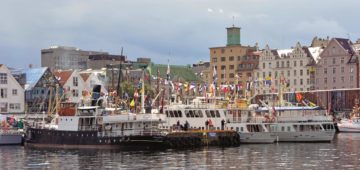


Comments
Sorry, comments are closed for this item